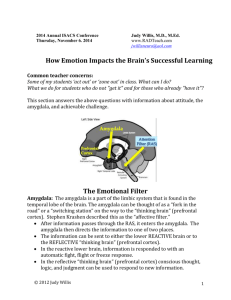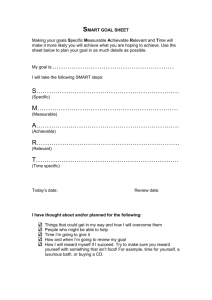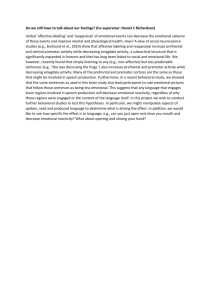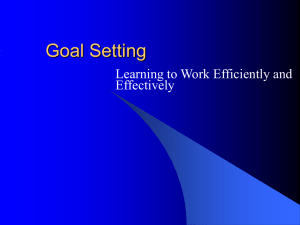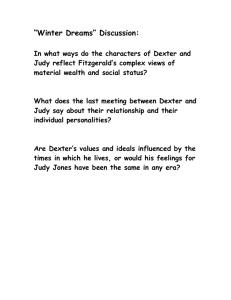Handout - McKay School of Education
advertisement
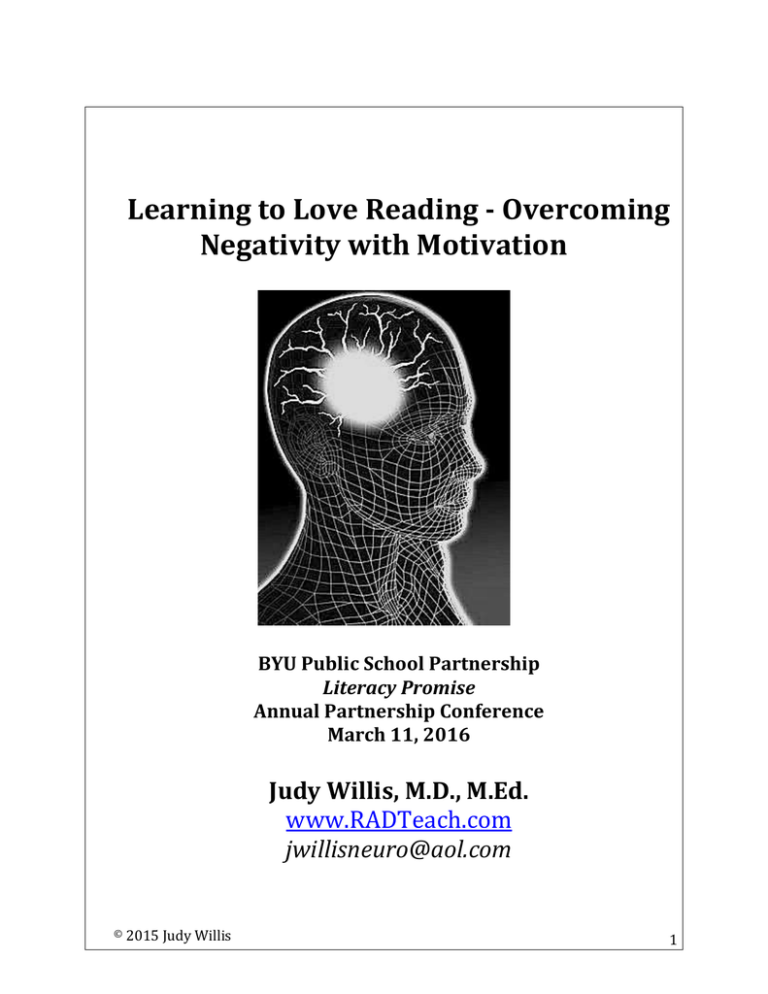
Learning to Love Reading - Overcoming Negativity with Motivation BYU Public School Partnership Literacy Promise Annual Partnership Conference March 11, 2016 Judy Willis, M.D., M.Ed. www.RADTeach.com jwillisneuro@aol.com © 2015 Judy Willis 1 Engaging Students from the Start Two Big Ideas of the Neuroscience of Learning: ★ The brain functions to promote survival of the animal and the species. ★ To do so, the human brain has evolved to seek patterns and pleasure. The Brain’s Structures -- Viewed from Left The Impact of Emotions on Literacy Building, Reading Comprehension, and Memory Common teacher concerns: Some of my students ‘act out’ or ‘zone out’ in class. What can I do? What can we do for students who do not "get it" and for those who already "have it"? This section answers the above questions with information about attitude, the amygdala, and achievable challenge. The Emotional Filter Amygdala: The amygdala is a part of the limbic system found in the temporal lobe of the brain. The amygdala can be thought of as a “fork in the road” or a “switching station” on the way to the “thinking brain” (prefrontal cortex). © 2015 Judy Willis 2 Stephen Krashen described this as the “affective filter.” After information passes through the RAS, it enters the amygdala. The amygdala then directs the information to one of two places. The information can be sent to either the lower REACTIVE brain or to the REFLECTIVE “thinking brain” (prefrontal cortex). In the reactive lower brain, information triggers an automatic fight, flight or freeze response. In the reflective “thinking brain” (prefrontal cortex) conscious thought, logic, and judgment enters to respond to new information. Information enters the amygdala REFLECTIVE “thinking brain” (prefrontal cortex) *conscious thought, decision making, judgment* REACTIVE lower brain *automatic fight, flight or freeze response* What determines if the amygdala directs information to the reflective “thinking brain” (prefrontal cortex) or to the reactive lower brain? When a person is in a state of high or sustained stress or fear: New information coming through the sensory intake areas of the brain cannot pass through the amygdala’s filter to gain access to the reflective prefrontal cortex. Incoming information is conducted to the lower, reactive brain. The lower, reactive brain has a limited set of behavior outputs: fight, flight, or freeze in animals – “act out” and “zone out” in students. Be aware of students who act engaged, but are bored or fearful of failing to achieve highest goals. Stress can reduce the ability of the hippocampus and prefrontal cortex © 2015 Judy Willis 3 to promote efficient working memory, emotional self-control, and attentive focus. Sources of school-related stress: Until the prefrontal cortex (PFC) matures, students are more reactive than they are reflective, especially when they perceive stress. Stress comes in many forms for students: o The boredom of already having mastery of the information being taught o No personal relevance and not being sufficiently interested in a topic or aware of how the topic relates to a student’s own interests or prior knowledge o Frustration from previous failures, being confused, and falling behind. This is equally stressful for students who get failing grades and for students who repeatedly fail to achieve the goal they (and their parents) set such as #1 in the class or all “A’s” o Fear of being wrong if asked to speak in class, answer questions, or present their work orally Promoting Transfer of Input through the Emotional Filter Reducing Stress Reduced stress promotes a relaxed and alert state in which information can pass through the amygdala and on to the reflective “thinking brain” (prefrontal cortex) for long-term memory and executive function processing. Students can build skills that allow the prefrontal cortex to over-ride the lower brain’s reactive impulses. • Participating in new learning requires students to take risks that are often beyond their comfort zones. Steps should be taken to reduce stress during these times. Students can learn how to become aware of their own stress and invoke strategies for relaxing and refocusing. • Promote Passage through Amygdala to PFC © 2015 Judy Willis 4 Guide students to: Monitor and control emotions Reflect before acting on emotions Experience control over sensory responsiveness (e.g. hearing a sound longer) Visualization: imaginary bubble to deflect hurtful actions & words Self-calm (deep-breath, observe themselves from “above”) Teach Students about Their Brains Learning how the brain processes input helps students develop more reflective PFC control over their reactive lower brains. Related Articles and Websites: How to Teach Students about the Brain link: http://www.radteach.com/page1/page8/page44/page44.html © 2015 Judy Willis 5 What You Should Know about Your Brain link: http://www.radteach.com/page1/page8/page45/page45.html Animated depiction of neuron network with axons, dendrites, and synapses: http://www.youtube.com/watch?v=frFiBNPVRl4&feature=youtu.be Neuroscience concepts and activities organized by grade level: www.brainfacts.org/About-Neuroscience/Core-Concepts Neuroscience for Kids: activities and interactive learning about the brain: http://faculty.washington.edu/chudler/introb.html#bb Promote Growth Mindsets People with a fixed mindset believe they are born with a certain amount of intelligence and skill, and that is all they will ever have. They believe that once they fail, there is no point in trying again, because they have reached their limit. Those with a growth mindset believe that people are given a certain amount of intelligence and skill, just as they have a certain body type, but that people have the potential to grow their intelligence and skill with hard work, just like a muscle. (Carol Dweck) The Video Game Model for Mindset, Engagement, and Perseverance The Brain Seeks Patterns and Pleasure Video and computer games are compelling because they offer individualized achievable challenges and frequent feedback of incremental progress that are physiologically rewarded with the intrinsic satisfaction produced by the brain chemical dopamine. At the outset, a player is presented with a goal. The player begins at level one, and through trial and error (feedback) builds enough skills to ultimately pass level one. © 2015 Judy Willis 6 The next level challenges and may exceed the player’s newly developed skills, but ultimately, through sustained effort, practice, and persistence the player succeeds and continues to progress through the levels. The player receives ongoing feedback and the dopamine boosting pleasure of incremental goal progress – reaching the next level. She feels the pride of knowing that her effort caused her success (intrinsic reinforcement). The player then seeks the greater challenge of the next level so she can continue to experience the ongoing pleasure of dopamine reward. The Video Game Model in the Classroom Video Game Model Includes: Goal buy-in Individualized achievable challenges Frequent feedback or awareness of incremental goal progress Goal Buy-in – Personal Relevance With goals designed to connect with students’ interests and authentic performance tasks they consider relevant, students want the knowledge tools they need to succeed. Students are then in the ideal state for motivated, attentive learning because they want to know what they have to learn. Examples of Personal Goal Relevance Show students how what they are about to study relates to their lives or the world around them. Watch a relevant video, such as those relating to math and science found at: http://www.thefutureschannel.com/ Connect a unit with current events Read aloud something curious that relates to the topic at hand Before a lesson or unit, tell a narrative about the life of the author, scientist, historical figure, or mathematician when he/she was about the age of your students Personalize information by connecting the topic to a person or place relevant to students (e.g. book author anecdote) Discuss the “So what?” factor. How the topic connects to the “real world” © 2015 Judy Willis 7 or to their lives. Relate how they are going to use the new information after you teach it to them (e.g. project, performance task, teach it to younger students)? Your Self-Assessment of Buy-In: How well do I promote buy-in? o How will I gather and use knowledge about my students to inspire their interests in new learning? o How will I relate the value of the learning beyond the classroom? o Do I use the power of questions and “I wonder…” statements to engage students’ attention and thinking? o Do I pursue learning myself so that I model the endless nature of mastering new concepts and abilities? Achievable Challenge Lower the Barrier, Not the Bar What we do for students who do not "get it" and for those who already "have it"? An achievable challenge is one in which a student has the capacity (or skills to develop the capacity) to meet an ambitious goal. As Goldilocks would say, the challenge is “not too hard, not too easy, but just right!” An achievable challenge exists within Vygotsky’s “zone of proximal development”. If a challenge is too easy, a student will become bored, which leads to stress, and ultimate disengagement from learning. If a challenge is too difficult a student will experience frustration and hopelessness, which, if sustained or frequent, also leads to excessive stress. However, when facing an achievable challenge that is just within their reach, students avoid the detrimental states of stress, and the amygdala is able to pass information to and from the prefrontal cortex. Achievable challenges prevent stress: reduce boredom & frustration One way of helping students to develop a growth mindset is to provide them with achievable challenges and alert them to their progress to sustain motivation, perseverance, and effort. © 2015 Judy Willis 8 Students are most motivated by the expectation of a dopamine reward when they learn at their individualized levels of achievable challenge. Providing students with achievable challenges reduces the reactive states resulting from the stress of boredom or frustration and promotes the intrinsic motivation of the video game model. In the ideal video game model all students would be learning in their personal zone of achievable challenge at all times. Frequent and ongoing assessments would guide the setting and resetting of instruction and skill practice throughout learning with the individual support needed to sustain the student’s efforts to overcome setbacks and obstacles. Although this individualization is not possible for all students, options will increase as technology provides resources for online learning “games”, lectures (flipped classroom), and enrichment opportunities for students already at mastery. While some students build basic math facts within their personal zone of achievable challenge with well-designed, interactive online learning programs, their teacher can concurrently guide others on inquiry projects and collaborations. What can teachers do to enable students to work within their achievable challenge level? Lower the barriers, not the bar: Communicate high expectations for all students and provide differentiation and support so students can achieve their goals. At the start of a unit clearly define the learning goals, success criteria, and types of assessments. Take time to provide examples of how students’ interests will be incorporated into their learning and how their strengths will be included in the assessments. • Use pre-assessments • Activate prior knowledge • Offer flexible groups • Use scaffolding and enrichment Scaffolding/Enrichment Key vocabulary lists with pictures and definitions, vocabulary pantomime © 2015 Judy Willis 9 Manipulatives for addressing misunderstandings in math Reading comprehension strategies to help all levels of readers read appropriately challenging texts (variety of levels of reading and alternatives such as video and audio sources of foundational information). These are explained in more detail below in learning selfquestioning strategies such as turning subheadings of texts into questions to answer as the chapter is read, jigsaw, “talk back to text”, three color highlighting Providing students the opportunity to discuss ideas before offering responses to questions (pairs or small groups). This is especially useful for students developing mastery of English as a new language or in foreign language classes before they respond orally in the foreign language. Increase reading comprehension of challenging texts with the following strategies: 1) “Talking Back to the Text” is an interactive reading strategy that helps students become personally engaged with what they read. Students begin by writing questions and prompts on post-it notes or other small papers that they can insert into their text. Some questions are prediction questions the student will answer before reading while others require response while the student is reading. Before reading the students writes and answers prediction questions: o I think you’ll be telling me… o I already know things about YOU so I predict..... During reading students can complete the following questions or prompts: o You are similar to what I have learned before, because you remind me of... o I would have preferred a picture of...(or sketch/download their own) o I didn’t know that and I find it interesting because … o I disagree because… o This is not what I expected which was… o This gives me an idea for … © 2015 Judy Willis 10 o I want to know more about this than you have to offer. I’ll find out by… o I have a different way of interpreting this information, which is… o I won’t let you get away with this statement, so I’ll check your source by …… o This could be a clue to help me answer the “Big Question” because… o I think this will be on the test because… 2) “Highlighting with Three Colors” Highlighting helps students understand complex texts with the use of a threecolor system. They’ll need a book they can write in, an on-line book/article, or if they can’t write in it, a copy of the pages you need to read. With the very complex text, instruct them to highlight the phrases they understand the first time in one color. They don’t need to go back to reread confusing sentences or look anything up. Just highlight the phrases that they understand – and that may be very little the first time. After that, just change marker colors and go through it again just highlighting any additional understood phrases with the new color. Repeat with the third color for the third reading. The highlighters can be any three colors, as long as you keep track of which order you use them in, such as: First reading: yellow Second reading: blue Third reading: green 3) Improve reading comprehension with the “think-aloud” strategy At home students should say out loud what they are thinking while reading, solving a problem, or answering questions. You can model this when reading a text in the classroom. Pause to illustrate to your students what you are thinking as you are reading the text. Online Learning Games for Scaffolding and Enrichment: These can be used for skill practice and feedback at the student's individual level of readiness © 2015 Judy Willis 11 Edutopia links to my blogs about On-Line Learning Games for foundational knowledge and practice: http://www.edutopia.org/technology-integration-research-evidencebased-programs Online Learning Game Resources: Graphite is a free service from Common Sense Media. They list many apps, games, websites, and digital curricula. http://www.graphite.org. EdSurge Product Reviews https://www.edsurge.com/p ClassroomWindow classroomwindow.com Ednak: peer-reviewed tools of education technology http://www.ednak.org/ Budget Hero (http://www.graphite.org/website/budget-hero) is an online game for building foundational knowledge about the United States and financial policy for students in grades 9-12. The website offers over thirty outside resources about budget, policy, and government information. The learning play offers authentic performance tasks about budgetary expansion, taxes and cuts. Students get feedback about the results of their actions. Newsela.com: Archive of more than 500 articles each at five reading levels, organized by category and reading standard. Students take quizzes and view progress Frequent Formative Assessment, Ongoing Feedback, & Awareness of Incremental Progress Students will experience the intrinsic pleasure of incremental progress if provided opportunities for ongoing formative assessments with feedback, reteaching, opportunities for self-corrections, and metacognition. With this exposure students can build understanding and progress at achievable challenge levels of success. In general we experience an intrinsic reward when we realize that we are making progress due to our practice and effort. Even noticing small changes can be helpful. For example, having students keep a graph of how their reading fluency improves based on how much they practice can be very motivating. The video game model gives students the opportunity to recognize both the intrinsic pleasure of incremental progress (“I got it” experience) and that the cause and effect relationship of expending effort towards practice and review brings them progressively closer to their goals. Students who feel alienated in school need additional support to regain their confidence and motivation towards reaching a challenging goal. If academic struggles have always been a source of disappointment, help students recall © 2015 Judy Willis 12 when they have been previously successful towards reaching other goals (e.g. music, sports, art, making friends, cooking something new, etc.). Analytic Rubrics for Incremental Progress Awareness Analytic rubrics follow the amygdala positive benefits of the video game model of achievable challenge and incremental progress. Rubrics allow all students to: Understand what is expected and how they can achieve steps of incremental progress along the way toward overall goal Experience the choice (a dopamine booster) of achievable challenge – where they will focus effort Develop metacognitive awareness so they can self-motivate (dopamine from intrinsic gratification) (REFERENCE: Nancy Pickett and Bernie Dodge. "Rubrics for Web Lessons." October 2001) Rubric Generator Websites http://www.teachervision.fen.com/teaching-methods-andmanagement/rubrics/4524.html#ixzz1d2xZeJck http://www.teach-nology.com/web_tools/rubrics/ http://rubistar.4teachers.org/index.php http://myt4l.com/index.php?v=pl&page_ac=view&type=tools&tool=rubricmaker Audio feedback can also be left in documents that are turned in through turnitin.com Effort=Progress to Goal Graphs Help your students use graphs to see the connection between their work, practice, effort, and their progress. Goals can range from time spent preparing for tests, number of answers correct on spelling tests, to progressing up rubric levels of proficiency in any subject. Help students build their own goaldirected behavior patterns by selecting the progress points they want to achieve on route to the final goal. Use small post-its or write in pencil when they believe they can reach each goal subdivision. As they progress they examine the accuracy of their projections and revise subsequent goal achievement dates and strategies accordingly. Sample graphs: www.onlinecharttool.com © 2015 Judy Willis 13 Your Challenges and Opportunities Start with One Student Teaching isn’t brain surgery – It’s harder Start with your achievable challenge – you need the validation of success to keep your dopamine-effort up Select one student where your efforts to “individualize” will have evident impact Be alert for improvements: ambient classroom noise, less tardiness, more participants in discussions, perceptive questions, less disruptive classroom behavior Emotion Summary 1. Emotions influence where new information is processed in the brain. For learning to become memory it must be directed through the amygdala to the prefrontal cortex. 2. High stress reduces information flow through the amygdala (emotional filter) to and from the cognitive/reflective brain (PFC). 3. During high stress, the survival instinct takes reactive control and responses are directed by the involuntary “lower” brain with output limited to fight/flight/freeze responses (act out/zone out). 4. The mammalian brain is wired to withhold effort when experience predicts a low probability of success. 5. The human brain can be “rewired” to reverse effort withholding when instruction follows the video game model: buy-in, achievable challenge, and frequent feedback of incremental goal progress. 6. The power behind the video game “model’s” impact on motivation and perseverance is the intrinsic reinforcement of the dopamine-reward response to accurate predictions and feedback of challenges achieved. 7. Goals that are clear, personally relevant, and believed to be achievable challenges are needed to promote brain “buy-in” and effort when previous efforts have not yielded goal success. © 2015 Judy Willis 14 8. In an amygdala-positive learning environment we see evidence of active learning and participating: o Students observing and noticing with focused attention (without act out/zone out) o Students discovering, thinking and questioning o Students who are engaged, motivated, interested, self-sustained learners To promote a positive attitude so that information gets to the prefrontal cortex (PFC): Use curiosity promoting questions/demonstrations and make learning personalized for “buy-in” Have students work in their zone of “achievable challenge” Teach students how to recognize their progress towards a goal Questions to Consider in Planning Units and Instruction in the Video Game Model How will students buy in from interest and relevance? What hooks will connect them from the beginning and what will sustain their interest in learning and understanding (predictions, audience relevance) How will I sustain awareness of big ideas and revisit them throughout (headlines, mind maps) How will I use formative assessments to gain feedback about students developing understanding, emotional comfort, and my success? How will I provide incremental progress feedback for students? WEBLINKS Website showing multiple examples of curriculum contents adapted to the video game model: http://ierg.net/lessonplans/unit_plans.php KWL Charts at readwritethink These free downloadable K-W-L Charts track what a student knows (K), wants to know (W), and has learned (L) about a topic, and can be used before, during, and after units of study or research projects. http://www.readwritethink.org/classroom-resources/printouts/chart-a30226.html © 2015 Judy Willis 15 Sample RAD lessons/units at ASCD edge Website http://edge.ascd.org/service/searchEverything.kickAction?keywords=lesson+plans&inclu deBlog=on&as=127586&sortType=relevance Judy Willis, M.D., M.Ed. © 2015 Judy Willis 16 www.RADTeach.com
